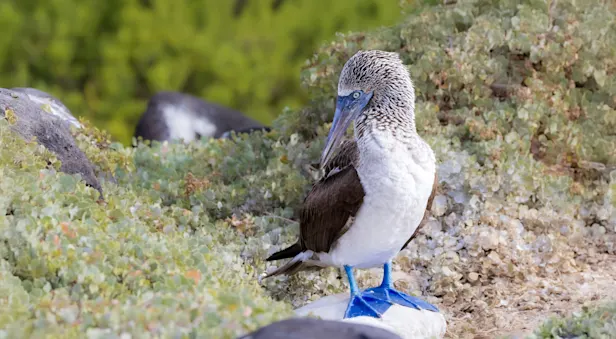
Know Before You Go


Lava Lizard Facts | Galapagos Islands Wildlife Guide
Similar to Darwin’s finches, the seven species of lava lizards most likely evolved from one single ancestor millions of years ago. They are physically less spectacular than the iguanas, but they are the most abundant reptile on the islands and are frequently seen scurrying around.
Physical Characteristics
They can reach up to 1 foot in length but are usually about 5 to 6 inches
The male is larger than the female and has a strong coloring of yellow, black and brown
Females have bright red skin under their throats
They have long, tapering tails and slim bodies
Range and Habitat
It is easy to separate the seven species of lava lizard by geographical distribution. One species occurs on the western and central islands, which were possibly connected during times of lower sea levels. And one species each occurs on the other six peripheral islands.
Behavior and Communication
Their most distinctive behavioral patterns are rapid head bobbing and push-up stances, which are performed in order to defend their territories and to assert dominance. They will also stand high on all fours and change color if they are threatened or if there is a temperature change. Scientists believe there are specific aggressive postures for each species, depending on which island they inhabit.
They are cold-blooded creatures and rely on the sun to keep them warm. During times of extreme heat, they retreat to shady spots to conserve energy.
Feeding Habits
Lava lizards are omnivores but dine mostly on insects. They eat spiders, moths, flies, beetles and some plants. They are extremely helpful in controlling insect populations, especially the painted locust. They sometimes live among humans and eat human foods, such as scraps found in trash or crumbs on floors.
Breeding and Reproduction
Males often mate with any female that passes through the male territory. Females lay three to six tiny eggs every month, which hatch after a 12-month incubation period. Females mature at nine months, and males mature after three years.
Lava lizard population sizes often depend on climate. During dry spells, populations decrease, and they will resort to eating seeds and sprouts.
Conservation
Lava lizards are food for hawks, snakes, centipedes, mockingbirds and herons. However, their major defense is their ability to drop their tails, literally. The tail keeps moving and attracting predators, while the lizard will flee or camouflage itself by remaining still and maybe hiding behind a rock. This is how they protect themselves. Human conservation efforts include managing domestic and feral cats, dogs and rats and, of course, guarding their habitat against human destruction.
Header Credit: Chris Willis
Marvel at Lava Lizards on These Galapagos Trips

Galapagos Discovery: The Nat Hab Experience
Small-group adventures aboard your choice of private yachts, led by our outstanding naturalist guides and photography pros. Snorkel and swim with sea lions, sea turtles and penguins on this incomparable nature odyssey.
































